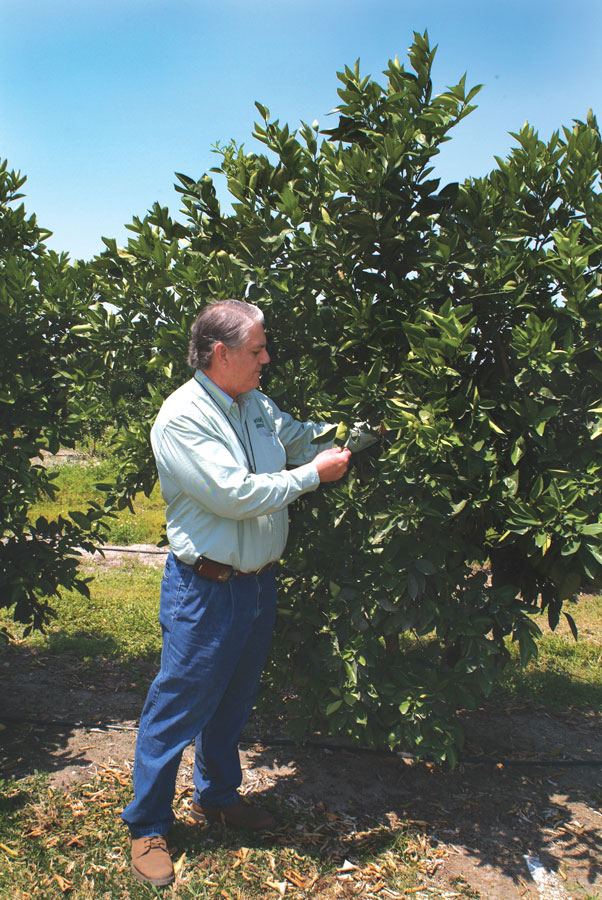November 13, 2012

Mike Murphy steps from the truckand strides quickly to an unusual-looking configuration of 25 month-old orange trees. Could this be a prototype for a citrus grove of the future? He intends to find out.
“With greening disease taking producing trees out, we’re trying to figure how to grow more boxes on smaller acreages,” says Murphy, CEO and executive vice president of Cooperative Producers, Inc., outside Immokalee, Fla.
“Some of our ranch was previously designed for trailer parking, so we decided to take that area and see how many trees we could put on a 50-foot bed. We got together with University of Florida professor Bill Castle and designed a program.”
Castle has experimented with designing and managing high density plantings at the university’s Citrus Research and Education Center at Lake Alfred.
“We put three tree rows on an existing 50-foot bed, planted eight feet apart in the drill,” Murphy says.
That puts 326 trees on an acre— more than double the usual number. Murphy calls this plot a modified advanced production system, using high-density planting, fertigation, and compact trees with efficient root systems.
“We chose semi-dwarfing root stocks,” he says. “Bill has 10 different replicated trials with root stocks, so we had a pretty good idea of what would work best.”
They used one microjet irrigation nozzle for every two trees, rather than the normal one-to-one setup. In addition, drip tape delivers moisture directly to the root zone, which should result in a more compact rooting pattern.
“The size of these trees is good,” Murphy says. “We composted them with a rototiller on a three-foot swath, using composted yard debris from the landfill. We brought it out here and tilled it into the soil.
Slow-release fertilizer
“At planting, we used a slow-release fertilizer. Then, the trees are fed once a month with fertigation. There’s a constant supply of water — we’re babying these trees.”
And it seems to pay off.
“We saw fruit in the second year,”Murphy says. “By the third year, you should be cash-flowing these trees.”
Young trees also receive an enhanced nutrient program. “The idea is to get a young tree to produce before greening gets it,” he says.
“I think we could do a big grove this way. The biggest obstacle is water, because there are more trees in the ground. We have to have drip tape, but we also have to have microjet — a dual system. We already have that on 40 acres in Hendry County.”
Murphy likes how the young trees responded to his team’s intensive management.
“This is the system of the future,” he says. “If I were to plant a grove now, we’d do this. I can see us rejuvenating 20-acre blocks with high-density planting.”
This grove design could also work well with mechanical harvesting. He also harvests some fruit with the current Oxbo harvester. The concept, which reduces reliance on hand labor, intrigues him.
“This type of grove will be perfect for the mechanical harvesting of the future. Researchers and engineers are now developing a machine to harvest these kinds of plantings,” he says.
Since smaller machines could be required for jobs like spraying, additional equipment redesigns may be necessary — but it’s not that big a deal, Murphy says, for the grove of the future.
The prototypegrove is just a small part of what Murphy’s team does to work with greening disease.
As of last spring, 16 percent of the trees on the groves he manages had been removed due to greening infestation since the disease appeared in 2006.
“As the latency period passed, after two and a half or three years, all of a sudden we saw huge spikes, and it scared the dickens out of us by 2009,” he says.
Since then, about 3.5 percent to 4 percent of their trees are removed each year because of greening disease.
Removing infestation
One tactic to minimize spreading the disease is to remove the infestation, he says.
“What we’re hoping is that by keeping inoculum levels down and growing young trees, we’re turning the tide.”
The company put 140,000 treesin three test project groves for four years. They remove the infestation when it is detected, strengthening trees with micronutrient applications.
“We flag the diseased trees,” Murphy says. “Then we spray a herbicide mixture that gets immediate kill, so the trees don’t have sprouts. Then, we wait two months to replant. That gives time for the herbicide to dissipate.
“We got it down to a .017 percent infestation rate. Our production is going up, and we’re getting more boxes of fruit per acre. Some of that has to do with nutrition and some with the fact that a lot of young trees are coming on.”
Blocks on other parts of the property get variations of that program. Some trees get the so-called Maury Boyd program — named for the citrus grower who developed it-of intensive micronutrient applications.
“We use some similar ingredients to Maury’s program and some different ones. We’re trying to find out which ingredients are effective and which are not needed.
For controlling the psyllid — the tiny insect vector spreading greening disease — Murphy strongly believes in the citrus health management area concept, in which growers within an area agree to spray for it in a coordinated fashion.
“We set up team captains in each region. The minute we see a sign of psyllids, we make a call to everybody and we begin the assault. An aggressive spray program is essential for control of psyllids. In southwest Florida, with its humidity and heat, the psyllid is going to be here,” he says.
“We don’t have the silver bullet for greening. My goal is to suppress the disease until someone can deliver a resistant tree or a material we can use for greening.”
You May Also Like




